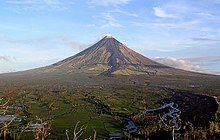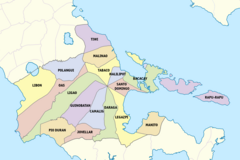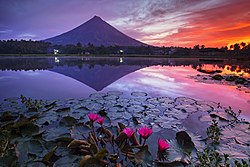
A | B | C | D | E | F | G | H | CH | I | J | K | L | M | N | O | P | Q | R | S | T | U | V | W | X | Y | Z | 0 | 1 | 2 | 3 | 4 | 5 | 6 | 7 | 8 | 9
This section needs additional citations for verification. (June 2023) |
Albay | |
|---|---|
| Province of Albay | |
|
From top, left to right: Mayon Volcano, Daraga Church in Daraga, Tabaco Church in Tabaco, SM City Legazpi in Legazpi, Bicol International Airport | |
| Anthem: "Albay Forever" | |
 Location in the Philippines | |
| Coordinates: 13°14′N 123°38′E / 13.23°N 123.63°E | |
| Country | Philippines |
| Region | Bicol Region |
| Founded | April 3, 1574 |
| Capital and largest city | Legazpi |
| Government | |
| • Governor | Edcel Greco Lagman (PFP) |
| • Vice Governor | Baby Glenda O. Bongao (Liberal) |
| • Legislature | Albay Provincial Board |
| Area | |
| • Total | 2,575.77 km2 (994.51 sq mi) |
| • Rank | 52nd out of 82 |
| Highest elevation | 2,463 m (8,081 ft) |
| Population (2020 census)[2] | |
| • Total | 1,374,768 |
| • Rank | 21st out of 81 |
| • Density | 530/km2 (1,400/sq mi) |
| • Rank | 12th out of 81 |
| Demonym | Albayano |
| Divisions | |
| • Independent cities | 0 |
| • Component cities | |
| • Municipalities | |
| • Barangays | 720 |
| • Districts | Legislative districts of Albay |
| Time zone | UTC+8 (PST) |
| ZIP Code | 4500–4517 |
| IDD : area code | +63 (0)52 |
| ISO 3166 code | PH-ALB |
| Spoken languages | |
| Website | albay |
Albay (IPA: [ɐlˈbaɪ]), officially the Province of Albay (Central Bikol: Probinsya kan Albay; Tagalog: Lalawigan ng Albay), is a province in the Bicol Region of the Philippines, mostly on the southeastern part of the island of Luzon. Its capital (and largest city) is the city of Legazpi, the regional center of the whole Bicol Region, which is located in the southern foothill of Mayon Volcano.[3]
The province was added to the UNESCO World Network of Biosphere Reserves in March 2016.[4]
History
Early history
Long before the Spaniards arrived, Albay had a thriving civilization. Formerly called Ibat, and then Libog, Albay was once ruled by Gat Ibal, an old chief who also founded the old barangay of Sawangan, now part of the City of Legazpi. Historian William Henry Scott wrote that in the local epic called siday entitled "Bingi of Lawan", an Albay datu by the name of Dumaraog went to the Lakanate of Lawan (present-day Laoang, Northern Samar) to ask for the hands of Bingi bringing with him 100 ships. Datu Hadi Iberein came from the Lakanate of Lawan. He was described by Scott as a “Samar datu by the name of Iberein was rowed out to a Spanish vessel anchored in his harbor in 1543 by oarsmen collared in gold; while wearing on his own person earrings and chains.”[5]
Spanish colonial era
In July 1569, Luis Enriquez de Guzman, a member of the expedition led by Maestro de Campo Mateo de Saz and Captain Martin de Goiti, led a group that crossed from Burias and Ticao islands and landed on a coastal settlement called Ibalon in what is now the province of Sorsogon. From this point, another expedition was sent to explore the interior and founded the town of Camalig.
In 1573, Juan de Salcedo penetrated the Bicol Peninsula from the north as far south as Libon, establishing the settlement of Santiago de Libon. Jose Maria Peñaranda, a military engineer, was made “corregidor” of the province on May 14, 1834. He constructed public buildings and built roads and bridges.
The entire Bicol peninsula was organized as one province with two divisions, Camarines in the northwest and Ibalon in the southeast. In 1636, the two partidos were separated, and Ibalon became a separate province with Sorsogon as the capital. In the 17th century, Moro slave raiders from the southern Philippines ravaged the northeastern coastal areas of the province of Albay.[6] By the end of the 1700s, Albay had 12,339 native families and 146 Spanish Filipino families.[7]: 539 [8]: 31, 54, 113
Mayon Volcano, in one of its most violent eruptions, destroyed the five towns surrounding its base on February 1, 1814. This eruption forced the town of Cagsawa to relocate to its present site, Legazpi.
A decree was issued by Governor-General Narciso Claveria in 1846 separating Masbate, Ticao, and Burias from Albay to form the comandancia of Masbate. Albay was then divided into four districts: Iraya, Cordillera or Tabaco, Sorsogon, and Catanduanes.
Philippine revolution
Glicerio Delgado, a condemned insurecto (insurgent), started revolutionary activities in the province. With a headquarters in the mountain of Guinobatan town, he joined the revolutionary government of Albay as a lieutenant in the infantry.
A unit of the Philippine Militia was then organized by the Spanish military authorities. Mariano Riosa was appointed major of the Tabaco Zone, which comprised all the towns along the seacoast from Albay to Tiwi while Anacieto Solano was appointed major for the Iraya Zone, which was made up of the towns from Daraga to Libon. Each town was organized into sections of fifty men under the command of a lieutenant.
During the Philippine Revolution on September 22, 1898, the provisional revolutionary government of Albay was formed with Anacieto Solano as provisional president. Major General Vito Belarmino, the appointed military commander, reorganized the Filipino Army in the province.
American invasion era
Following the Spanish–American War, the new colonial power the United States did not recognize the country's independence, which had been declared in June 1898, and the Americans subsequently acquired direct control of the country as a de facto colony, under the terms of the Treaty of Paris (1898), over which the Filipinos had no say.[9] During the Philippine–American War, Brigadier General William August Kobbé headed the expedition that landed at the ports of Sorsogon, Bulan and Donsol. From there, the Americans marched to Legazpi and captured it.
Although a civil government was established in Albay on April 26, 1901, Colonel Harry Hill Bandholtz, Commanding Officer of the Constabulary in the Bicol Region, said that General Simeon Ola, with a thousand men, continued to defy American authority after the capture of Belarmino in 1901. Ola was later captured with about six hundred of his men.
Japanese occupation era
Following the December 12, 1941, Japanese invasion of Legazpi during the Second World War, the Kimura Detachment of the Imperial Japanese Army occupied Albay Province. The region was defended only by the Philippine Constabulary unit under the command of Major Francisco Sandico.[10]
During the Japanese Occupation, the military general headquarters of the Commonwealth Army of the Philippines remained active from January 3, 1942, to June 30, 1946, and the 5th Constabulary Regiment of the Philippine Constabulary was established from October 28, 1944, to June 30, 1946, and stationed in Albay. Then came the clearing operations and anti-Japanese insurgency in the Bicol Peninsula, helped by the local Bicolano resistance. Some Bicolano guerrilla groups invaded around the province of Albay during the Japanese Insurgencies between 1942 and 1944 and were supported by local Filipino troops under the Philippine Commonwealth Army and pre-war Philippine Constabulary 5th Infantry Regiments attacking the enemy soldiers of the Japanese Imperial Army. In the aftermath of three years of siege and conflicts, many Bicolano guerrillas were forced to retreat by the Japanese around the province before liberation in 1945 by Allied forces.
Geography

Albay has a total land area of 2,575.77 square kilometres (994.51 sq mi),[11] which makes it the 53rd biggest province. The province is bordered by the provinces of Camarines Sur to the north and Sorsogon to the south. To the northeast lies Lagonoy Gulf, which separates the province from Catanduanes. To the southwest of the province is the Burias Pass with the island of Burias of Masbate province located about 14 kilometres (8.7 mi) offshore.
In 2016, an area of 250,000 hectares (620,000 acres) was declared a UNESCO Biosphere Reserve. The Albay Biosphere Reserve is home to 182 terrestrial plant species, of which 46 are endemic to the Philippines. Its marine waters and coastal area also provide habitat to five of the world's seven marine turtle species, as well as mangrove, seagrass and seaweed ecosystems.[12]
Topography
The province is generally mountainous with scattered fertile plains and valleys. On the eastern part of the province is a line of volcanic mountains starting with the northernmost Malinao in Tiwi, followed by Mount Masaraga and the free-standing Mayon Volcano. Separated by the Poliqui Bay is the Pocdol Mountains in the town of Manito.
The stratovolcano of Mayon standing at around 2,462 metres (8,077 ft), is the highest point of the province. It is the most famous landform in Albay and in the whole Bicol Region. This active volcano falls under the jurisdiction of eight municipalities and cities of Albay: Camalig, Daraga, Guinobatan, Legazpi City, Ligao City, Malilipot, Santo Domingo, and Tabaco City.
The western coast of the province is mountainous but not as prominent as the eastern range with the highest elevation at around 490 metres (1,610 ft).[13] Among these mountains are Mount Catburawan in Ligao and Mount Pantao in Oas.
Administrative divisions
Albay comprises 15 municipalities/towns and three component cities (Legazpi, Ligao and Tabaco).









